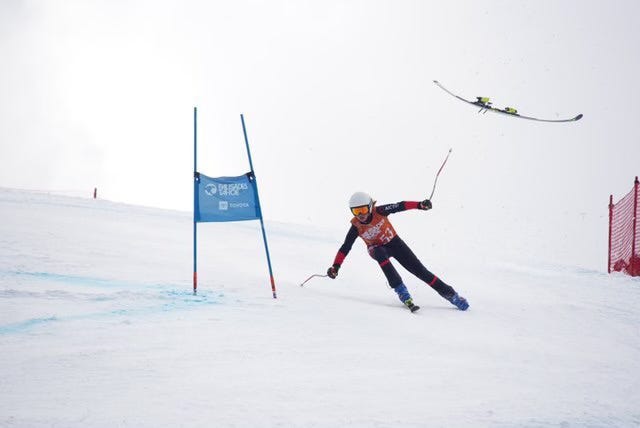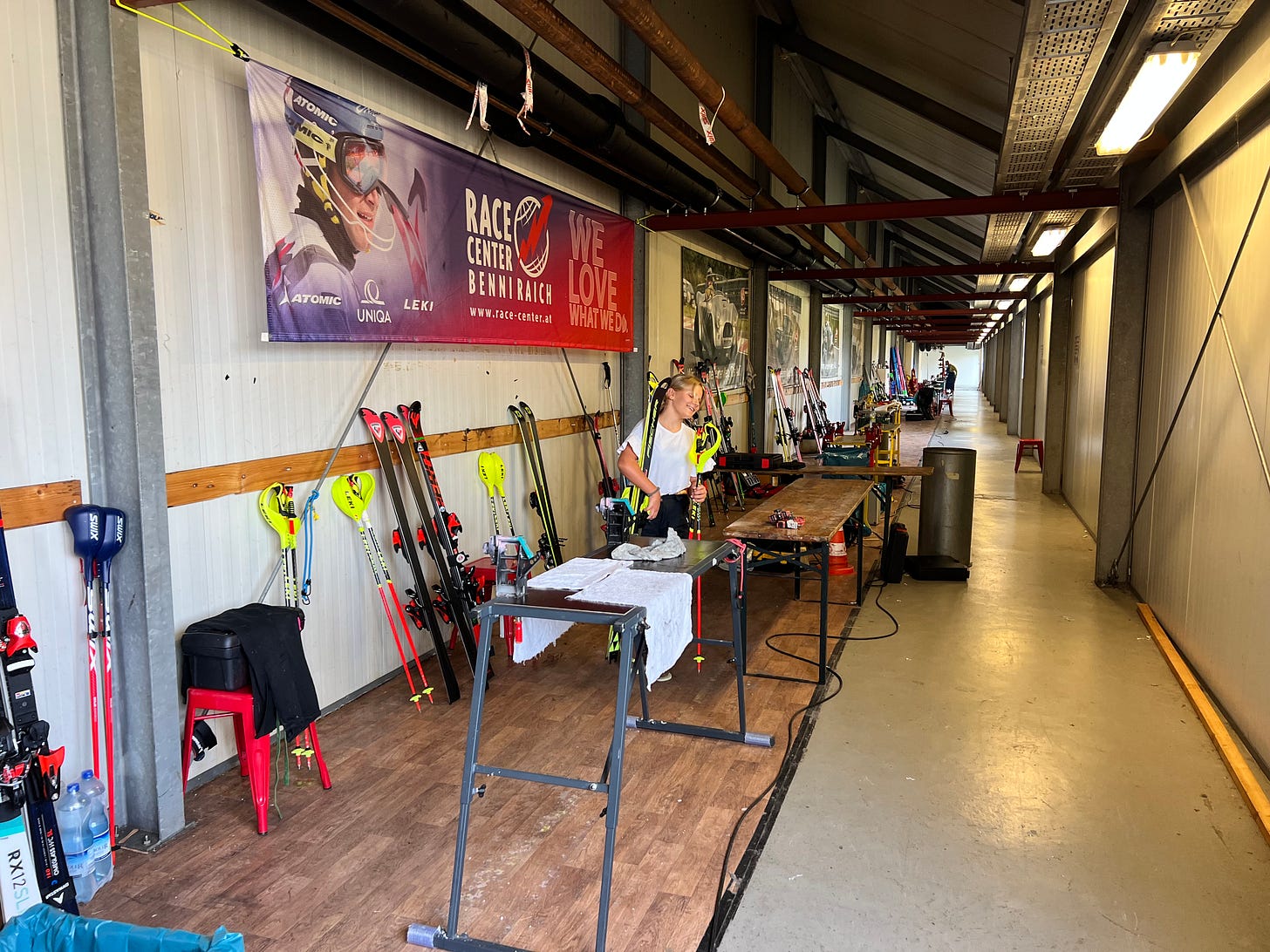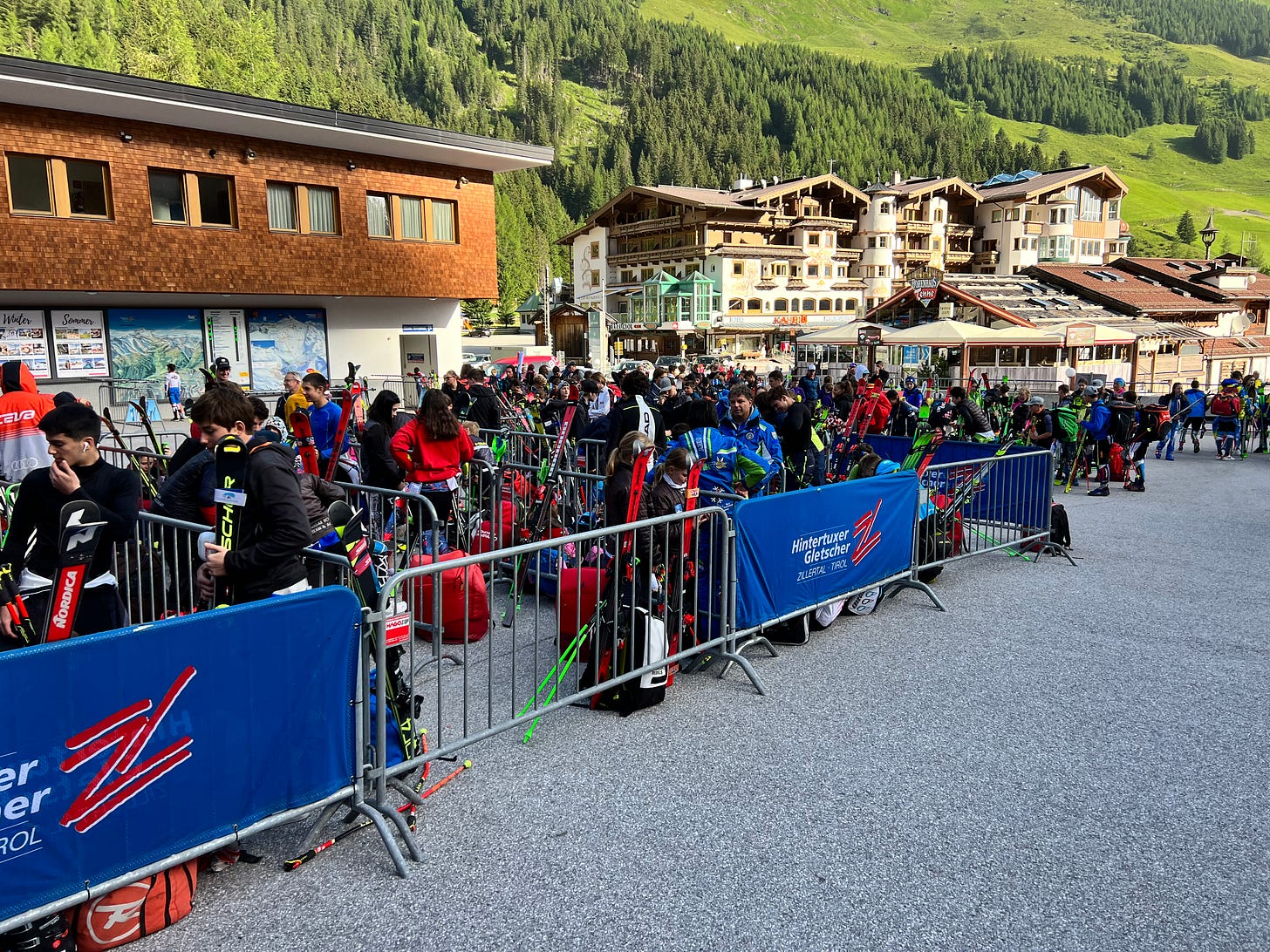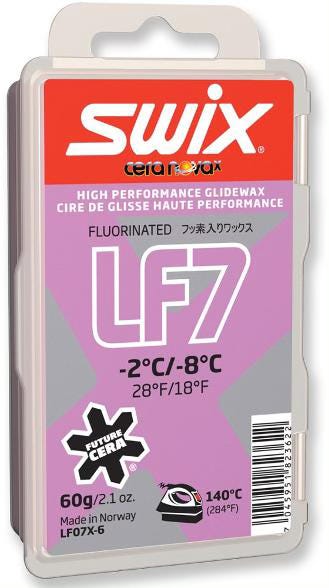Welcome to "Schneezeit" ⛷️
A newsletter for parents of alpine ski racers - gear, tuning, fitness, mental prep, and academics. Written based on the lessons learned from raising three young racers.
I still remember the evening before our son’s first U8 race. Standing in the wax room the night before, I had decided to take things into my own hands - quite literally, with a block of red wax in one hand and a wax iron in the other.

Did I know what I was doing? Absolutely not.
But you have to start somewhere I was telling myself, and used YouTube as my instructor. I had purchased my tuning gear at Start Haus, our local store ski racing store in Truckee. A bench, an iron, a wire brush, a couple of roto brushes (nylon, boar), a horse hair brush, a cork, and a new DeWalt drill which I had bought on the drive up at The Home Depot in Auburn. I also had Diamond files with 240, 500 and 1000 grit.
That was ten years and some 200 pairs of tuned skis ago… Since then, I've been lucky enough to learn from some of the best coaches and ski technicians in the sport—the ones who prep skis for World Cup racers and Olympic champions. Through trial and error (mostly error), I've discovered what works and what doesn't. Meanwhile, our kids have also attended two ski academies and raced both in the US and Europe (Italy), so I know a little bit about the intersection of skiing and academics.
With this newsletter, I am sharing that knowledge with you.
Why a newsletter for ski racer parents, why now?
The biggest variable in racing is still the racer.
But all things being equal, the right ski, mental and academic prep can make or break your kid’s results. Coaches are one source of information, but they need to look after the whole team. So as a parent, you need to be aware of everything that can impact your child’s performance and happiness.
The greatest World Cup racers had their parents always behind them, on and off the slopes: Vonn, Shiffrin, Odermatt, Giradelli, Tomba, Ljutić, Cochran, Kostelić (2x!), Kristofferson - to name a few.
In particular for understanding gear, tuning, waxing, fitness and practice, there are three changes that have made knowledge about more relevant than ever:
Expanded talent pool
Changing snow conditions
New types of waxes
We’ll see how sa minor tweak in your gear and wax choice can affect the outcome of your race among these changes. And how skiing is not just a sport for kids growing up in the mountains anymore.
Expanded talent pool
Racing is no longer limited by geography or traditional access routes. Indoor facilities, glacier camps and academies with year-round training have created a much broader base of competitive athletes.
Teams practice on glaciers and indoors during the summer months (for the Northern Hemisphere), and go to camps in Chile and New Zealand. Below is an image of the line at the Hintertux Glacier Express in early June at 8:01am in the morning. This is on a school day…
If you ask British racer Dave Ryding how he won the 2022 Kitzbühel slalom, he will likely tell you “by practicing in Wittenburg”, the indoor alpine center east of Hamburg, Germany. Ryding out-practiced the Austrians, French, Swiss, Italians and Germans in what’s essentially a giant freezer.
To practice at world-cup level you need to have skis tuned at world-cup level. Below is a photo of the “tuning alley” in Wittenburg where the various teams set up their stations. You can see our daughter Olivia (then 10 years old) picking up her skis.

These professional levels of preparation, which used to be reserved to FIS racers like Ryding, have trickled down and are now standard practice for young, competitive skiers. If you want your kids to be able to keep up, they ideally practice during offseason as well, every month. And when they do so, they need to be on pair of well-tuned skis. Every day.
Changing snow conditions
Changing snow conditions have made precise waxing and tuning critical. Warmer winters, more variable temperatures, and rapid snow condition changes during spring races (usually the time of championships) require smarter tuning strategies.
Take the slalom race in Chamonix during the 2023/24 season, on a February 4th. Swiss racer Daniel Yule was 30th after the first run, a full two seconds behind leader Clement Noel. With the reverse starting order, Yule went first on course in the second run.
The sun was shining bright that day, warmed up the course, made the snow more moist and therefore slower by the minute. Because of these changing conditions, none of the other 29 racers were able to keep their advantage on Yule. He ended up winning the race.
Go straight to this section in the video to see how Yule couldn’t believe it himself. In all of the FIS racing history, it had never happened that a 30th place managed to make up 29 places and end up as the winner. All because of changing snow conditions.
New types of waxes
You’d think that the World Cup technicians would have prepared for these changing conditions in Chamonix. It’s not their first rodeo after all. So what happened?
Yule is of course an amazing skier, but in this race he wouldn’t have made it even close to the podium if racers had been allowed to use so-called “fluorinated wax”. Fluorinated waxes perform particularly well in moist conditions, such as the ones at the Chamonix race. The FIS banned all fluorinated waxes in 2019, and started enforcing the ban until 2021 when they had the technical methods to put testing and discovery into place.
Fluorinated waxes aka “fluoro waxes” contain per- and polyfluoroalkyl substances (PFAS). How PFAS work exactly is material for another post, but in short fluorinated wax makes your skis faster by creating a moisture- and dirt-repelling layer between your base and the snow. That layer reduces friction and increases your glide.
PFAS represent an environmental and health hazard. Also known as “forever chemicals”, they are persistent, bioaccumulative, toxic, and remain in the body for long periods of time. They are associated with an increased risk of certain types of cancers. PFAS end up in our bodies through exposure to aerosols and fumes when hot-waxing, and through snow melt which ends up in our water systems.
The fluoro ban is a good thing. It has created a shift in wax technology, with manufacturers now investing into the development of high-performance, eco-friendly alternatives that can match the glide characteristics of traditional fluorinated waxes. But that also means we have to understand the chemistry behind these new waxes, and how they affect the performance of our skis.
Create confidence
We’ve now learned how understanding the science (and chemistry) of ski preparation has become a necessity for young racers in order to compete.
But it’s not just about speed.
Properly prepared skis create confidence for young racers. So does athletic and mental preparation. When your skis grip and glide the way they should, in any condition, and your body is strong and your mind is clear, then you can focus on technique and speed instead of fighting your equipment.
When young racers have confidence in their ski preparation, it creates a powerful psychological edge. Well-prepared skis become more than just equipment—they're a source of psychological security. For a young athlete, this confidence translates to a powerful mental state: feeling fully equipped, professionally supported, and ready to compete at their absolute best.
Building a community
This isn't just a newsletter—it's a space where ski parents can learn, share, and support each other. Whether you're new to the sport or have been tuning skis for years, you'll find valuable information here:
Step-by-step guides for basic and advanced tuning
Review of gear and tools that actually work
The science behind ski bases, wax, and the elements
The world of ski academies and colleges
I’ll pull in knowledge and tips from the experts - World Cup technicians, shop owners, racers, experts from wax, machine and gear manufacturers, and coaches and directors of ski academies in the US and Europe, for an end-to-end coverage.
What to expect
You'll receive a new post every other Sunday. Each post will be practical, detailed, and based on real experience. Future posts will cover everything from basic ski preparation to the science behind wax and the machinery to make your skis fast.
The world of ski tuning doesn't need to be mysterious or overwhelming. Whether you're preparing skis for a future champion or just want your recreational skier to have the safest, most enjoyable experience possible, this newsletter is for you.
Welcome to Schneezeit. Let's make this season the best one yet.



